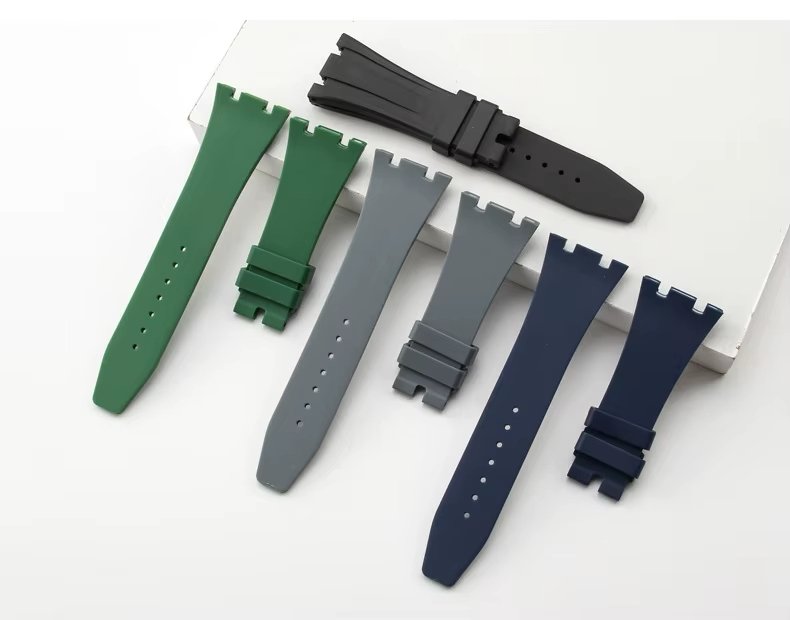Discover the world of luxury vintage watches.
Watches from our catalogue, just for you.
Royal Oak Chronograph | 26240ST | Cal. 4401
Learn on how to handle your timepiece with care.
-
Owning an automatic luxury watch is all about enjoying the precision and artistry of its movement while understanding how it works. The magic of an automatic watch lies in its self-winding mechanism. As you wear it, a weighted rotor inside spins with the natural motion of your wrist, winding the mainspring and keeping the watch powered. If you wear the watch daily, it will stay wound and keep time without needing much attention.
If you haven’t worn the watch for a few days and it stops, a quick manual wind will get it going again. To do this, pull out or unscrew the crown to the winding position and turn it clockwise about 20-30 times. This gives the mainspring enough energy to start running again. After that, as long as you wear the watch, the rotor will take care of the rest.
Setting the time and date requires a little care, especially with watches that have a date complication. Avoid adjusting the date between 9 PM and 3 AM, since the watch’s gears are already working on the date change during these hours. Forcing it could damage the mechanism. If your watch has stopped, wind it first, then set the time, making sure it’s outside that danger zone. After that, you can safely adjust the date using the quickset function, if your watch has one.
One cool feature of many automatic watches is "hacking," where the second hand stops when you pull the crown out to set the time. This makes it easy to synchronize the time down to the second. Once everything is set, push the crown back in (or screw it down, if your watch has a screw-down crown) to seal it properly.
-
Owning a chronograph watch combines the classic elegance of timekeeping with the functionality of a stopwatch. The chronograph movement features additional subdials and pushers that allow you to measure elapsed time with precision. Understanding how to handle and operate your chronograph will ensure it functions smoothly and keeps accurate readings.
When using the chronograph feature, it’s important to know how the pushers work. The top pusher (usually at 2 o'clock) starts and stops the chronograph, while the bottom pusher resets it to zero. To begin timing, press the top pusher gently, and the chronograph seconds hand will start moving. To stop the timer, press the top pusher again. When you’re ready to reset, press the bottom pusher to return the hands to zero.
When setting the time on a chronograph, the standard rules still apply, but be mindful of the pushers and their impact on the chronograph function. Avoid pressing the pushers while setting the time, as it could damage the movement. Always ensure the pushers are fully retracted before using the chronograph.
Additionally, many chronographs feature a tachymeter or other specialized scales on the bezel or outer dial to calculate speeds or distances. These scales require careful use, and any adjustments should be done with precision to avoid overuse of the pushers.
If you’re not actively using the chronograph, ensure the pushers are pushed in fully to avoid accidental activation. Regular maintenance, including checking for debris around the pushers and ensuring the seals are intact, will help preserve the functionality of the chronograph for years to come.
-
A luxury watch with complications, such as calendars, tourbillons, or other intricate features, offers a deeper level of mechanical sophistication. These additional functions enhance the watch’s functionality and make it a true horological masterpiece. Proper handling ensures that these complications operate smoothly and accurately.
Calendars
Watches with calendar complications often feature functions like date, day, month, or even annual or perpetual calendars. When setting these features, it’s essential to understand their specific nuances.
Date Adjustment: Avoid setting the date between 9 PM and 3 AM to prevent damaging the date-change mechanism. During these hours, the gears are engaged in the date change, and manually forcing adjustments can lead to complications.
Month Adjustment: Watches with monthly or annual calendars require manual intervention at the end of each month to ensure accurate date display. For perpetual calendars, adjustments are typically needed only at the turn of the year.
Tourbillons
Tourbillons are among the most intricate complications in watchmaking, designed to counteract the effects of gravity and improve accuracy. These movements require extra care due to their delicate nature.
Handling: Avoid sudden shocks or impacts, as the delicate tourbillon mechanism can be vulnerable to damage.
Wind and Wear: Keep the watch worn regularly to maintain the power reserve and ensure the tourbillon operates smoothly. If left unworn, manually winding the watch will provide the necessary energy for proper function.
Other Complications
Complications like moon phases, power reserves, and GMT functions offer additional functionality, but require similar attention to their specialized operations.
Moon Phases: These complications may require adjustments once a month or year depending on the watch's design. Regular checks ensure they stay in sync with the lunar cycle.
GMT/World Time: For watches with dual time zones or world time features, ensure accurate alignment of the second timezone to avoid potential misalignment during travel or frequent use.
Regular servicing is recommended for watches with multiple complications, as their complexity increases the likelihood of needing professional maintenance. By following these guidelines, you’ll ensure that each complication operates flawlessly, enhancing your overall experience with a truly exceptional timepiece.
Check out our newly released SVW Essentials collection.
Book an appointment with us.
Can’t find what you’re looking for? Looking for advice? Don’t worry, we’ve got you. Plan an appointment and our team will be helping you as best they can
solesellvintagewatches@gmail.com









